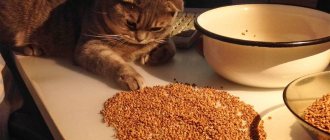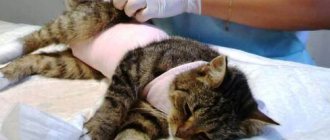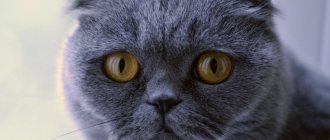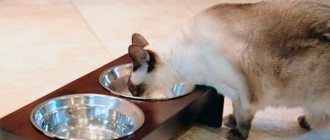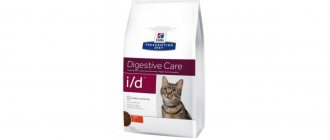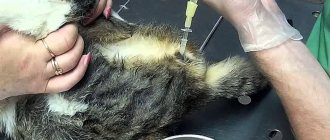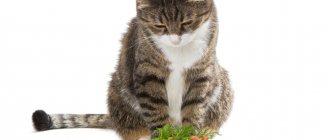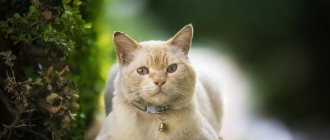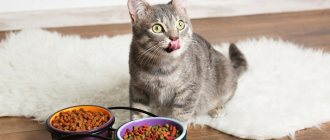Basic rules for feeding a cat with diabetes
To normalize the condition of a cat with diabetes, it is necessary to adhere to a feeding regimen. Veterinarians recommend 4–6 meals.
Four meals a day: two main feedings + two small snacks. Studies have proven that insulin levels in cats are maximum 3 hours after injection. This peak is combined with the main feeding. Snacks are given to the animal before the injection.
The basis of a diabetic cat's diet is protein and fiber. The amount of carbohydrates consumed is minimized. The percentage of energy (calorie) obtained from them is not higher than 12%, for older animals with obesity - 6%.
A diabetic diet for a pet is based on the principles of maintaining normal body weight, strengthening muscle tissue and reducing glucose consumption. Therefore, cats are prescribed a low-carbohydrate diet. Foods labeled as high in protein are not always suitable for diabetic cats. So, in addition to a large percentage of proteins, they contain a large amount of fat. Such feeding of sick animals leads to obesity, which is extremely dangerous in diabetes.
A balance between protein and carbohydrate intake is necessary to maintain normal blood glucose levels in the animal. Controlling the amount of fat a cat eats is necessary as a prevention (treatment) of obesity.
Proteins do not cause a strong insulin response in a cat's body. Therefore, lean varieties of meat and fish are optimal for feeding a pet diagnosed with diabetes.
Carbohydrates contained in starch, pasta, and bread are excluded. The body of even a healthy animal is not adapted to absorb large amounts of carbohydrates.
Switching to a low-carbohydrate diet helps achieve remission in diabetic cats. Stabilizing the animal’s condition allows one to avoid insulin injections.
Feeding cats when they are vomiting
Feeding for kidney failure
Feeding cats with diabetes
The basis of nutrition for a cat with diabetes is either low-carbohydrate food or natural products. There is no consensus among veterinarians which food is better, wet or dry. Canned food for cats is more often recommended, but there are a large number of brands of dry food on the market with a low percentage of carbohydrates, fats and high proteins.
The diet or food is selected by the veterinarian, taking into account the type of diabetes, concomitant diseases, degree of obesity and age of the animal.
Adhere to the following rules:
- Four or six meals a day according to schedule. Cats are fed at the same time.
- Do not mix food types - industrial feed or natural products.
- Do not mix the two types of food, dry or wet. The brand of food is not changed, only if absolutely necessary.
- Provide your pet with access to clean drinking water.
- Watch your portion size.
After consultation with a veterinarian, cats, especially those with obesity, are given fasting days. Compliance with nutritional standards improves the health of the animal.
Control
It is very important to have constant medical supervision. After the first symptoms of the disease appear, a comprehensive examination of the animal is carried out: in addition to blood and urine tests, tests for hormones, acid-base balance levels, ultrasound and an electrocardiogram must be done. But even after establishing a diagnosis and prescribing therapeutic measures, you need to regularly visit a doctor to monitor the effectiveness of treatment. It is necessary to regularly take blood and urine tests to check how changes are progressing in the cat's body. The owner needs to keep a special journal where all the data on insulin injections, the amount of liquid drunk, food used, test results and the weight of the cat must be regularly entered.
Natural products
The diet of a diabetic cat consists of proteins and fiber. For feeding, choose low-fat varieties of meat and fish. Proteins are given in boiled form, raw foods are prohibited.
Protein foods can be mixed with a small amount of vegetables, which are steamed or boiled. Fresh vegetables are not recommended for feeding pets with diabetes.
Protein in a cat's menu is 50% - 60%, fermented milk products - 25%, fats - 25%, the rest is vegetables with a low glycemic index. The percentage of carbohydrates in the diet does not exceed 4%–5%.
The table shows approved foods for cats with diabetes.
| Product | Cause |
| Lean meat (chicken, turkey, beef) | They contain the required amount of protein and do not cause an insulin “spike” in the animal’s body. Proteins are a source of amino acids involved in building the animal’s muscles and prevent the development of obesity and muscle atrophy. There is a strengthening of skeletal muscle - the basis for insulin-mediated deposition and absorption of glucose. |
| By-products (liver, kidneys) | Source of protein. |
| Fish (sea, lean) | A source of protein, consumption is limited to pets with concomitant kidney diseases or urolithiasis. |
| Cottage cheese, sour cream (fat content up to 20%) | Contains protein and the required amount of fatty acids. |
| Vegetables (carrots, cauliflower, zucchini, beans) | Fiber slows down the release and absorption of glucose. Has a beneficial effect on the functioning of the gastrointestinal tract. |
It is strictly forbidden to feed a pet with diabetes from the “master’s table”. When preparing natural food, no salt or spices are used.
Foods high in starch and carbohydrates are excluded from the diet. Cats are not given bread, baked goods, pasta, or some types of cereals.
The table shows prohibited foods for cats with diabetes.
| Product | Cause |
| Rice and corn porridge | They contain a lot of starch - a source of carbohydrates that are not completely absorbed by the cat's gastrointestinal tract and cause an increase in glucose in the animal's blood for a long time. |
| Pasta | Contains simple carbohydrates. |
| Flour products (white, brown bread, baked goods, pastries) | Carbohydrate food. |
| Soy, products made from it | Source of starch, carbohydrates. |
| Sausages, smoked meats, canned food | They contain large amounts of salt and spices that are dangerous even for healthy cats. |
General information
Many owners who learn about the terrible diagnosis of their pet fall into panic. After all, diabetes cannot be cured, the pet will need every minute care, constant treatment, and this will seriously hit the family budget. Some people imagine such terrible pictures that they even think about euthanizing the animal. There is no need to rush, let’s first understand all the nuances.
Insulin is a hormone that is produced in the body of a healthy animal by the pancreas and all this happens without outside intervention. With diseases of the pancreas and some other ailments, insulin production is sharply reduced or stops altogether. Another scenario also happens - the body’s cells do not want to accept insulin for some reason.
Insulin is a stimulant that acts on cells, more precisely, their membranes. When the membranes contract, sugar (glucose) enters the cell through the resulting window. The membrane closes, the cell processes sugar and receives energy (calories). When there is not enough insulin or it cannot affect cells, the body is deprived of glucose, which has a detrimental effect on all vital systems. This condition is called hyperglycemia and it is fatal if the animal does not receive help.
Trying to get rid of excess sugar, the body begins to produce more urine (glucose is excreted in the urine). Feeling constantly thirsty, the cat drinks and urinates more. Excessive water consumption is the first alarm bell, indicating obvious disorders (not necessarily diabetes). Diabetes (mellitus) in cats is divided into three types:
- I – destruction of pancreatic cells occurs, insufficient insulin is produced.
- II – enough insulin is produced, but the cat’s body does not perceive it.
- III is a mixed type, which involves a sharp lack of insulin for 3-5 weeks against the background of the body's immunity (type II). However, after therapy (insulin injections), the cat’s well-being improves and the condition is consolidated in type II.
Type I diabetes is complicated, but it is also rare. To live, a cat with type I must constantly receive insulin from the outside, that is, the owner needs to give injections. Type II disease is more common in cats. This type of diabetes is effectively controlled by diet, blood sugar-lowering medications, and quality care. At the same time, the diet of cats with type II diabetes mellitus should be carbohydrate-free. There is no need to worry too much about this; unlike humans, it is common for a cat to consume a large amount of protein (protein) and receive carbohydrates in very small quantities.
Wild cats do not eat porridge, beans, rice, or corn and do well. The reason is that the cat's liver synthesizes glucose, which is enough to nourish the nervous system and brain. People are structured completely differently; without carbohydrates, a person literally loses strength and can fall into a state of acidosis, which is apparently why owners are so scared of their pet’s no-carbohydrate diet.
What happens if a cat with diabetes gets a lot of carbohydrates (sugar, glucose)? Water consumption and urination will increase, we have already talked about this. If this symptom is missed and the cat continues to receive high-carbohydrate food, for example, dry food (even high-quality, but not medicinal), excess glucose in the blood will inhibit the functioning of the pancreas... and this is a vicious circle. Fortunately, you can break this cycle, you just need to remember what wild cats eat.
So, a healthy wild cat eats meat and entrails along with their contents. In energy terms, this is approximately:
- 50–55% protein(s).
- 22–25% animal fats (not vegetable!).
- 3-4% carbohydrates if the caught victim has recently eaten.
The cat's body also synthesizes glucose from the resulting protein. The process is long, the resulting glucose is very pure, but it is there. In addition, do not forget that the cat’s liver synthesizes glucose, even if the cat eats only proteins and animal fats. With this approach we get the following:
- There is unusually little glucose in the blood.
- The pancreas tries to produce more insulin, because the cells need glucose, and they are hungry.
- The overall resistance of cells to insulin decreases because the concentration of insulin is much higher.
Simply put, the less glucose a cat gets from food, the more glucose its body will absorb. If this seems strange to you, you might want to do some more research about diabetes. According to this principle, the disease is treated not only in animals, but also in people.
Special feed
Therapeutic food for diabetic pets not only reduces glucose levels and normalizes its absorption, but also helps fight obesity and muscle atrophy. The brand is selected by the veterinarian, taking into account the type of disease, the age of the animal, and the presence of concomitant diseases.
When choosing food yourself, give preference to foods high in protein, low in fat and carbohydrates. Products labeled “high protein” may contain a high percentage of fat and have a high calorie content. They are not suitable for cats with diabetes.
Premium, superpremium and holistic food classes have a truly healing effect. Products from the “economy” lines, despite advertising, contain a large percentage of carbohydrates and are not suitable for feeding animals with diabetes.
Wet food is most often recommended for pets with diabetes. They contain less carbohydrates and lower calorie content. Canned food is easier for older cats to digest.
We have compiled the Top 5 foods for cats with diabetes.
Monge Vetsolution Diabetic Feline
Dry food.
Compound:
- Protein – 35%.
- Lipids – 10%.
- Mineral and vitamin supplements – 7%.
- Fiber – 8%.
Additives:
- L-carnitine – 100 mg.
- Vitamin A – 25,000 IU.
- Vitamin D3 –1750 IU.
- Iron – 176 mg.
- Iodine – 2 mg.
- Copper – 14 mg.
- Zinc – 150 mg.
- Selenium – 0.28 mg.
Ingredients: hydrolyzed chicken protein, salmon, freeze-dried duck meat. The food contains insoluble pea fiber and brewer's yeast.
Calorie content 3600 kcal/kg.
Pros: contains L-carnitine, which improves metabolic processes and helps fight obesity. Regular consumption of food reduces the need for insulin.
Cons: sold only in veterinary clinics. Not suitable for feeding pregnant cats
Purina
Available in canned or dry food form.
Compound:
- Proteins – 13%.
- Fats – 5.5%.
- Total content of vitamins and minerals (raw ash) – 2.2%.
- Fiber – 0.9%.
- Carbohydrates <0.5%,
- Starch –0.4%.
Vitamins and minerals:
- Retinol – 1200 IU.
- D3 – 160 IU.
- Tocopherol – 180 IU.
- Fe – 11 mg.
- I – 0.43.
- Cu – 1.08 mg.
- Zn – 30 mg.
- Se – 0.02 mg.
- Taurine – 1350 mg/kg.
Ingredients – meat, its processed products, fish, its processed products, fiber processed products.
Calorie content 0.99 kcal/g.
Pros: designed specifically for cats with diabetes, normalizes metabolism.
Cons: Contains corn starch. Not suitable for feeding pregnant cats
Brit Veterinary Diet Cat Grain free Diabetes
Dry food.
Compound:
- Proteins – 46%.
- Fats – 13%.
- Mineral, vitamin supplements – 7.7%
- Fiber – 3%.
- Starch – 15%.
- Sugar – 0.8%.
Additives:
- Omega-3 fatty acids – 3 0.55%.
- Omega-6 fatty acids – 6 1.6%.
- Retinol – 26000IU.
- Vitamin D3 – 1000 IU.
- Tocopherol – 1000 mg.
- Ascorbic acid – 300 mg.
- Taurine – 2,300 mg.
- L-carnitine – 600 mg.
Ingredients: dehydrated chicken, yellow pea protein, chicken fat, dried seaweed, intestinal flora stabilizers.
Calorie content – 3,740 kcal/kg.
Pros: the food does not contain grains and has a low glycemic index.
Cons: Not suitable for feeding pregnant cats.
Farmina Vet life Diabetic
Dry food.
Compound:
- Proteins – 46%.
- Lipids – 13%
- Vitamin, mineral supplements – 8%.
- Fiber – 5%.
- Sugar – 0.33%
Additives:
- Retinol – 15000 IU.
- D3 – 1000 IU.
- Vitamin E – 550 mg.
- Ascorbic acid – 250 mg.
- Pantothenic acid – 42 mg.
- Vitamin B6 – 7 mg.
- L-lysine – 4000 mg.
- Taurine – 2500 mg.
- L-carnitine – 550 mg.
Ingredients: freeze-dried chicken, pork, corn gluten, oats. The food contains beet pulp and flaxseed.
Calorie content 3503 kcal/kg.
Pros: contains L-carnitine, a large percentage of vitamins and minerals.
Cons: contains corn gluten, which causes allergies. Not suitable for feeding pregnant cats
Hill's Prescription Diet (Diabetes)
Available in the form of canned food and dry food.
Compound:
- Proteins – 50%.
- Fats – 21%.
- Carbohydrates – 18%.
- Fiber – 4%.
- Raw ash – 6.2%.
Vitamins, microelements, additives:
- Ascorbic acid – 115 IU.
- Tocopherol – 612 IU/kg.
- L-carnitine – 556 IU.
- Omega – 3 fatty acids – 0.34%.
- Omega-6 fatty acids – 3.6%.
- Retinol – 6791 IU/kg.
- Vitamin D3 – 647 IU/kg.
Ingredients: freeze-dried chicken, chicken meal, corn gluten, pea protein.
Calorie content – 3950 Kcal/kg.
Pros: contains L-carnitine, omega fatty acids.
Cons: high carbohydrate content, contains corn gluten. Not suitable for feeding pregnant cats
Fertilizers and vitamin supplements
With diabetes, the animal's body experiences a lack of vitamins. This is due to metabolic disorders and the need to adhere to a strict diet. The lack of nutrients is compensated by taking special complexes.
A veterinarian will help you choose the right supplements and feeds. When choosing vitamins for your cat on your own, give preference to complexes for overweight or older animals.
The complexes include the following elements:
- Retinol (vitamin A) – provides antioxidant protection, binds highly toxic oxygen compounds. Production, which increases in cats with diabetes.
- Ascorbic acid (vitamin C) – participates in antioxidant protection. The compound binds free radicals. The number of which increases in diabetic animals. Vitamin C slows down the formation of cataracts and glaucoma in cats with high blood sugar.
- Tocopherol (vitamin E) is an antioxidant that slows down fat oxidation. In diabetics, the compound reduces blood hypercoagulation and slows down atherosclerotic processes.
- Selenium - in addition to its antioxidant effect, the substance reduces blood glucose levels and prevents degeneration of pancreatic tissue.
- B vitamins – strengthen nerve fibers that are damaged by diabetes.
- Zinc – stimulates insulin synthesis, promotes the normal functioning of the hormone. The microelement increases the immune defense of the skin and prevents the appearance of purulent wounds.
Included in vitamin complexes for cats with diabetes are chromium and manganese. Microelements are involved in the synthesis of insulin.
Controlling a pet's diet for diabetes eases the animal's condition and leads to remission. It is important to prevent obesity and stimulate the cat’s mobility.
Complications of the disease
Diabetes mellitus leads to disruption of the functioning of all organs and systems of the animal. The most serious complication is ketoacidosis. With improper treatment and a constant lack of glucose, the cat’s body processes fats from reserves in the liver. This leads to the formation of ketone bodies, which poison the blood. An overdose of insulin may cause hypoglycemia. These two conditions require immediate medical attention or the animal will die.
In addition, diabetes mellitus causes liver dysfunction and frequent infectious diseases. In sick cats, the condition of the coat deteriorates and skin diseases appear.
